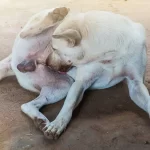Why Does My Dog’s Hair Stand Up
Have you ever wondered why your furry friend’s hair stands up at certain times? Perhaps you’ve noticed this phenomenon during playtime or when they encounter another dog on their walk. In this article, we’ll explore the reasons behind why a dog’s hair stands up and what it means for their behavior.
Hair standing up, also known as piloerection, occurs when tiny muscles attached to each hair follicle contract. This contraction causes the hair to stand straight up, making your dog appear larger than usual. While humans don’t have these muscles, many animals do – including dogs.
One reason for piloerection is fear or anxiety. When a dog feels threatened, their body goes into “fight or flight” mode. Their heart rate increases, breathing becomes rapid, and adrenaline floods their system. Piloerection is a physical response to this stress – it makes the dog look bigger and more intimidating to potential threats.
Another reason for hair standing up is excitement. Dogs may get excited during playtime with their owners or when encountering other dogs on walks. Piloerection in this context is a sign of arousal and can be accompanied by wagging tails and playful barks.
Piloerection can also occur when a dog is experiencing pain or discomfort. If your dog suddenly develops raised hairs along their back or neck, it could be a sign that they’re in pain. It’s important to monitor your pet closely if you notice this behavior and seek veterinary attention if necessary.
Certain breeds of dogs are more prone to piloerection than others due to their genetics. For example, Siberian Huskies and Alaskan Malamutes have thick coats designed for cold weather. These breeds have more muscle fibers attached to each hair follicle, making them more likely to experience piloerection.
In conclusion, there are several reasons why a dog’s hair may stand up – including fear, excitement, and pain. It’s important to pay attention to your pet’s body language and behavior to determine what may be causing this response. Remember, each dog is unique, and what works for one may not work for another. If you’re unsure about your pet’s behavior, consult with a professional dog trainer or veterinarian to ensure the best possible outcome for both you and your furry friend.
And if you’re feeling down, just remember – even dogs have bad hair days sometimes!



